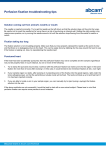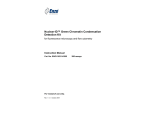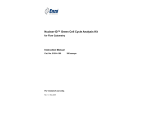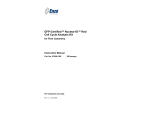Download TROUBLESHOOTING TIPS - IHC
Transcript
TROUBLESHOOTING TIPS - IHC No staining The primary antibody and the secondary antibody are not compatible. Use secondary antibody that was raised against the species in which the primary was raised (e.g primary is raised in rabbit, use anti-rabbit secondary). Not enough primary antibody is bound to the protein of interest. Use less dilute antibody, Incubate longer (e.g. overnight) at 4°C. The antibody may not be suitable for IHC procedures which reveal the protein in its native (3D form). Test the antibody in a native (non-denatured) WB to make sure it is not damaged. The primary/secondary antibody/amplification kit may have lost its activity due to improper storage, improper dilution or extensive freezing/thawing. Run positive controls to ensure that the primary/secondary antibody is working properly. The protein is not present in the tissue of interest. Run a positive control recommended by the supplier of the antibody. The protein of interest is not abundantly present in the tissue. Use an amplification step to maximize the signal. The secondary antibody was not stored in the dark. Always prevent the secondary antibody from exposure to light. Deparafinization may be insufficient. Deparaffinize sections longer, change the xylene. Fixation procedures (using formalin and paraformaldehyde fixatives) may be modifying the epitope the antibody recognizes. Use antigen retrieval methods to unmask the epitope, fix for less time. The protein is located in the nucleus and the antibody (Nuclear protein) cannot penetrate the nucleus. Add a permeabilizing agent to the blocking buffer and antibody dilution buffer. The PBS buffer is contaminated with bacteria that damage the phosphate groups on the protein of interest. Add 0.01% azide in the PBS antibody storage buffer or use fresh sterile PBS. High background Blocking of non specific binding might be absent or insufficient. Increase the blocking incubation period and consider changing blocking agent. Abcam recommends 10% normal serum 1hr for sections or 1-5% BSA for 30 min for cells in culture. The primary antibody concentration may be too high. Titrate the antibody to the optimal concentration, incubate for longer but in more dilute antibody (a slow but targeted binding is best). Incubation temperature may be too high. Incubate sections or cells at 4°C. www.abcam.com/technical The secondary antibody may be binding non-specifically (damaged). Run a secondary control without primary antibody. Tissue not washed enough, fixative still present. Wash extensively in PBS between all steps. Endogenous peroxidases are active. Use enzyme inhibitors i.e. Levamisol (2 mM) for alkaline phosphatase or H2O2 (0.3% v/v) for peroxidase. (See IHC protocol). Fixation procedures (using formalin and paraformaldehyde fixatives) are too strong and modified the epitope the antibody recognizes. Change antigen retrieval method, decrease the incubation time with the antigen unmasking solution. Too much amplification (Amplification technique). Reduce amplification incubation time and dilute the amplification kit. Too much substrate was applied (enzymatic detection). Reduce substrate incubation time. The chromogen reacts with the PBS present in the cells/tissue (enzymatic detection). Use Tris buffer to wash sections prior to incubating with the substrate, then wash sections/cells in Tris buffer. Pemeabilization has damaged the membrane and removed the membrane protein (membrane protein). Remove permeabilizing agent from your buffers. Non-specific staining Primary/secondary antibody concentration may be too high. Try decreasing the antibody concentration and/or the incubation period. Compare signal intensity against cells that do not express the target. Endogenous peroxidases are active. Use enzyme inhibitors i.e. Levamisol (2 mM) for alkaline phosphatase or H2O2 (0.3% v/v) for peroxidase. (See IHC protocol). The primary antibody is raised against the same species as the tissue stained (e.g Mouse primary antibody tested on mouse tissue). When the secondary antibody is applied it binds to all the tissue as it is raised against that species. Use a primary antibody raised against a different species than your tissue. The sections/cells have dried out. Keep sections/cells at high humidity and do not let them dry out. www.abcam.com/technical






